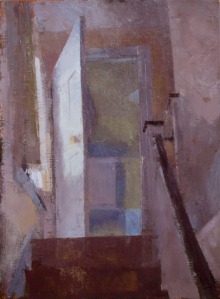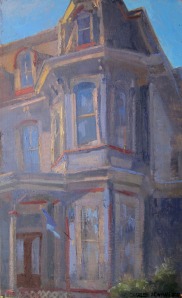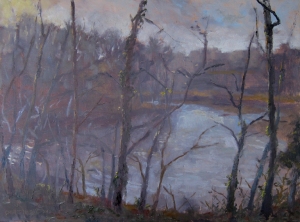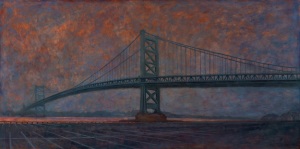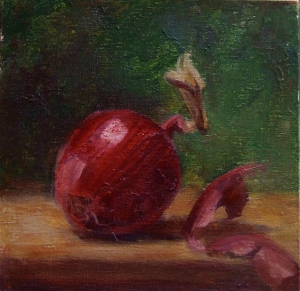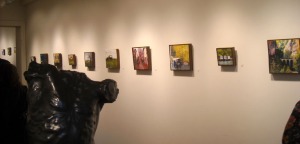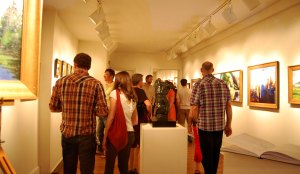Thanks Public Walls for the great review.
Tag Archives: First Friday
David Bottini: New Paintings
New Paintings by David Bottini opens Friday, March 1, 2013
March 1 – 30, 2013
First Friday Opening Reception March 1, 5-9 PM
David Bottini’s realist landscapes explore light and atmosphere. His approach begins in direct observation and is enhanced and developed in the studio using a traditional glazing approach. His work draws from training in classical realism as well as his passion for a post-modern abstract sensibility in composing a viewpoint.
Charles Newman- Plein Air Painter
Charles Newman will have nearly new 40 oil paintings on display this month at F. A. N Gallery. Newman’s paintings are atmospheric – giving the viewer just enough information to connect to the painting and infer one’s own meaning into the interior spaces, still lives or landscape. The paintings’ sketchy and layered paint or scraped down textures allows the viewer to discover more about the painting with each investigation.
I have been corresponding with Charles while he prepared for Charles Newman: New Paintings, March 2 to 31, 2012.
What do you think about when you paint?
The thought of painting stays with me whether I am painting or not. When painting, I try to keep my thoughts simple. Degas said he didn’t think much when he’s painting and I can relate with that. Overall, things work out better for me in the end when I keep it simple.
[When painting] I break down what I see to the basic shapes and forms. I think about the properties of the paint itself. The way one color reacts next to another color. That’s what painting is about. I imagine having a mentor looking over my shoulder constantly reminding me about these things.
Sometimes I have an imaginary dialogue with students when I’m painting, explaining how to find color tonal relationships and good paint application. However, painting is spontaneous.
When doing plein air painting, it’s a race against time. I simplify things to get the overall moment and feeling from the motif. I ask myself what’s important to include and what’s not. I usually go wrong when I think too much and too objectively about things and try to include every window or every downspout in the painting. I’m making a painting, not doing carpentry. For me, that exhausts the painting, but it happens sometimes and I have to remind myself not to worry about stuff like that. Painting is design. I recognize certain passages within the motif and if I like the way a passage looks, I let it be. If I don’t like the way it looks, I’ll scrape it back and repaint it. I heard someone say a while ago to “think slow and paint fast”, and I always keep that in mind.
Charles works for City of Philadelphia Mural Arts Program and I wondered if his mural work influenced his personal painting work?
Not really, I feel they are two separate practices. Working on a mural is so different for me, in fabrication, paint application, subject, etc. But one thing that influences me when working on murals is the exploration of various neighborhoods, which have elements that I’m interested in when doing my own painting. Sometimes while painting a mural outside, I look across and see light hitting the side of a house a certain way, and I think to myself, I’d rather be painting.
Who are your influences, artistic or otherwise?
I have many influences. Many are painters from the 18th and 19th centuries, and early 20th century. My wife (who is very influential and supportive) recently got me a couple of art books. One is Edouard Vuillard, who is a great influence. I relate to his work because of the direction my own work has been going in. He did a lot of homely, domestic scenes with a spontaneity and honesty within them – something I try to do in my paintings. I also love his use of composition.
Corot has been an influence of mine for a while. I used to take a book of his work, In the Light of Italy, out of the library all the time when I was going to Pennsylvania Academy of Fine Art. I may have had a few late charges on it. This book focuses on a group of painters who painted the land and elements of Italy during the 18th and 19th century and the importance of the oil study. In my opinion, I see Corot as one of the fathers of en plein air painting.
Two other influences include Charles Hawthorne and Robert Henri. Not only am I influenced by their work, I am influenced by their writings on teaching. Charles Hawthorne has a book Hawthorne on Painting and Robert Henri’s The Art Spirit. I feel that these are the “helping friendly books” on painting. These are books I can always go back to during my practice. So when I feel my painting is getting stale, these writings help me refresh my painting.
Some of my present day painting influences include Scott Noel, Al Gury, Dan Miller, Jon Redmond, former classmates and family.
Do you prefer to work in the studio or plein air?
I prefer working en plein air and on location because my paintings are representational. I strive to capture the actuality and simplicity of things. I consider my French easel being a portable version of my studio that I can take on the road. It has adjustable clips to prop my painting at a comfortable height, and it has a little table with a little drawer for me to store and use my supplies, which is great. At home, the detached garage that I converted into a studio is primarily used as a workshop to prepare surfaces, frames and rocking out to music. I rarely paint in the studio.
You talk about “filters” in your statement. What kind of filters do you mean?
When I mention filters in my artist’s statement I mean direct observation of the type of light, the filtering of light through atmosphere. If I’m painting on a humid day, I’ll treat my palette differently than if I was painting on a cold day.
On a cold day with no humidity, the light and shadow is crisp and on a humid day where there is more water in the air, the light feels softer and hazier, and I’ll mix accordingly.
The other thing I mean by “filter” is the ability to simplify through seeing. Squinting my eyes helps to eliminate details and distinguishes the tonal comparisons, so I have a better idea about shapes and edge quality. It also helps me distinguish the local colors and the true spots of color.
One example [of filtering] is the painting “Lake at Croft Farms”. I am facing slightly west, where the sun is receding. With the brightness of the sunlight radiating from the background of my subject matter, the light has diffused a cool bluish glow or filter within my field of view. This enables me to block in a very large mass and easily know my local color. Local color is the overall average of the color range within my field of view. Or the color that is mostly seen within the field of view. Squinting or blurring our eyes help to find the local color because everything gets simplified and we see spots of color. The local color is usually a mid tone color within the range.
___________
Charles Newman’s work will be on display March 2 through March 31, 2012 at F. A. N. Gallery
Opening Reception is Friday, March 2, 2012, 5 to 9 PM.
FAN in Philadelphia Style Magazine
Fred of the initials in F.A.N. Gallery was interviewed for the article, The Gallerists Who Further First Fridays in Philadelphia Style Magazine.
Filed under Events
Matt Greenway, F. A. N.’s July Artist
I met F.A.N.’s July artist, Matt Greenway, when we were both teaching at Fleisher Art Memorial. I have admired his work for the last 10 years and I am glad that he is now exhibiting at F.A.N.
Matt and I recently talked about some of his working methods and inspiration. I was familiar with some of his older work and have been delighted with the direction of his newer paintings.
KM: Your work that I am most familiar with is from 2001 to 2009. It seems that the paintings are getting looser and the tone is warmer.
MG: There are definitely tendencies toward looser handling in my work. I hope as I mature as a painter, my handling will be less constrained, like many painters I admire. Right now, the larger pieces are more controlled, finished pieces. I tend to be looser in my smaller works and especially my gouaches. I gravitate to smaller work, some my most favorite paintings are small.
KM: How have your paintings changed over the years and is it a conscious effort to change or is it evolving on its own?
MG: My evolution as a painter has been influenced by who I happen to be looking at any given point and I paint in a style reminiscent of painters I like. Some recent autumn paintings were inspired by the work of Daniel Garber . I saw quite a few inspiring pieces at the Pennsylvania Academy of Fine Art’s Museum of American Art a few years ago. I’m still processing that show. The Gathering was an attempt to paint a tapestry-like piece in Garber–like fashion.
KM: Has your painting process changed over the years and has that influenced your style?
MG: The gouache paintings have informed my oils. They help me understand the importance of freshness in a painting because you cannot fuss with a gouache or it quickly becomes stale. I think this is true of oil painting as well.
KM: Switching gears a bit. What makes you paint?
MG: Painting is one way I deal with my mortality – or at least avoid the thought of the end. My demise seems most distant when I have a paintbrush in my hand. I am comforted by the silly notion that a few of these works will probably survive me. Painting has a lot of things going for it despite it being an antiquated medium. It affords me a number of things; it is an effort to make meaning of what I see, it is a dialogue with paintings of the past; it gives me a sense of purpose or worth.
KM: What about the landscape or cityscape attracts you?
MG: There is a rich tradition that I am looking to when I commence painting a landscape. There are nearly always a dozen great artists who have painted what I have painted or something like what I have painted [before]. What I find exciting is how I will depict the scene and what this says about my work and who I am. In this sense, I find painting a process of self-discovery as well as mediation on the world and the tradition of painting.
I’m also inspired by what I think would make an interesting painting. This usually involves what I see during everyday life, as well how this intersects with photography and art history. I cannot paint a pear without thinking about how a dozen other painters might go about this. And in the process of painting that pear I find, through what I choose to include and what I choose to leave out, what kind of painter I am.
KM: Can you tell me about your process?
MG: With the exception of still-life, I usually paint an underpainting. In gouache, I paint it in yellows and reds and finish with a cool, then a full color final layer. In oil, I begin with variations of dark reds and whites – what is a Venetian method, I think. I try to keep the darks lean and build up the whites. Then I paint a whole other layer on top of this. This way, I find by essentially painting the image twice you learn how the painting works the second time around. Using such a method, Sickert said you may, “learn the song so you can play it by heart”.
KM: How do your paintings come together: plein air, in the studio, or a mix?
MG: The gouaches or opaque watercolor are often done on site. Still-lifes are done from life in the studio. Otherwise, I paint landscape in the studio from digital or scanned photographs. I sometimes manipulate images on the computer to better understand tonal relationships. Sometimes, I will work from three totally different images of the same picture and take what I need to create the painting. One needs a fresh eye. And when you work indirectly, depending on one image is frequently not enough.
KM: Do you mean three pictures of the same subject from different points of view or three differentially colored or valued versions of the same photo, i.e. a black and white version, a red version or blue version? By “fresh eye” you mean the different images give you a fresh perceptive on the subject?
MG: Frequently, it’s the same image. I usually desaturate it, and simplify or amplify the tonal values of the image. It’s also important to know the right time to put the source material away and work on the painting on its own terms so that it can stand alone. After all, I’m interested in making a painting – not a painted photo, not photo-realism.
KM: What type of size and surface do you like to work on?
MG: In oil, I work on canvas, muslin, or panel. Someone recently remarked that you can recognize a former Lennart student by whether he paints on muslin or not. In gouache, I prefer hot press [paper], the heavier the better.
KM: Do you do drawings to get started?
MG: On site I’ll do a bare-bones sketch but usually dive in [with paint]. With small oils, I usually work on the underpainting without a drawing and just arrange simple masses. With large works, I generally square them up initially, find a few key points and lay in the masses.
KM: Matt, I know it can be hectic right before the exhibition opening, thanks for taking the time to talk with me about your work and process. The new paintings are beautiful and it was great to get some insight as to how you work.
Please come to F.A.N. Gallery to see Matt Greenway: Recent Paintings, July 1st — 31st, 201, Opening Reception First Friday: July 1st, 5 — 9 p.m.
Filed under Artists
Kate Kern Mundie: New Paintings June 3rd Opening Reception
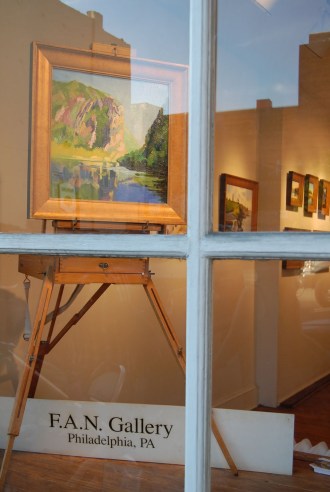
Kate Kern Mundie: New Paintings, June 3rd Opening Reception
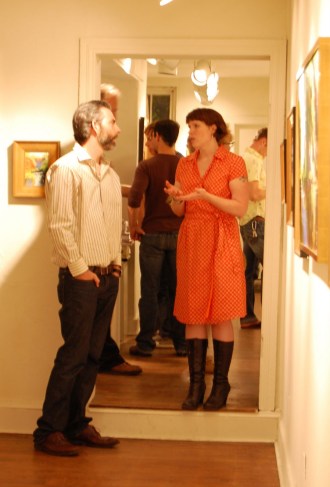
Matt Greenway, F.A.N. Gallery's July 2011 artist and Kate Kern Mundie F.A.N. Gallery's June 2011 artist
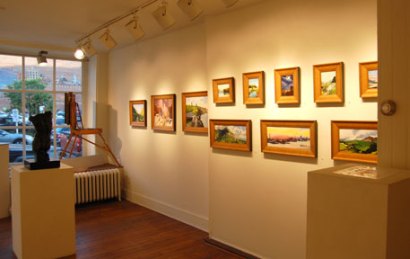
The paintings installed

Kate Kern Mundie: New Paintings, June 3rd, 2011 Opening Reception.
Upcoming Events
May 1-29, 2011: Tezh Modaressi
opening reception: Friday, May 6th, 5-9 PM
June 1-26, 2011: Kate Kern Mundie
opening reception: Friday, June 3rd, 5-9 PM
July 1-30, 2011: Matt Greenway
opening reception: Friday, July 1st, 5-9 PM
August 5-27, 2011: Group Show
opening reception: Friday, August 5th, 5-9 PM
September 2-24, 2011: Kathy Weber
opening reception: Friday, September 2nd, 5-9 PM
October 7-29, 2011: Serge Zhukov
opening reception: Friday, October 7th, 5-9 PM
November 4-26, 2011: Lesa Chittendem Lim
opening reception: Friday, November 4th, 5-9 PM
December 2-31, 2011: Rick Buttari
opening reception: Friday, December 2nd, 5-9 PM
Filed under Events




